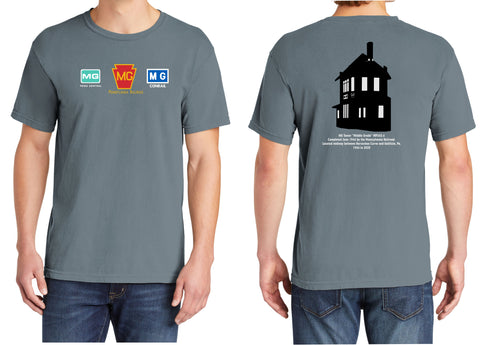Southern Railway Logo Embroidered Cadet Collar Sweatshirt
- Embroidered on Front
- 50% cotton, 50% polyester
- air jet yarn creates a smooth, low-pill surface for printing
- cross-dyed shades (2 colors in one fabric)
- YKK® brass zipper and contrast Dark Grey trim
- 1x1 ribbed cuffs and waistband with spandex
- double-needle stitching throughout
- fleece-lined collar
- Color Meadow/Black
The Southern Railway (reporting mark SOU) (also known as Southern Railway Company and now known as the current incarnation of the Norfolk Southern Railway) is a name of a class 1 railroad that was based in the Southern United States. The railroad is the product of nearly 150 predecessor lines that were combined, reorganized and recombined beginning in the 1830s, formally becoming the Southern Railway in 1894.[1]
At the end of 1971, the Southern operated 6,026 miles (9,698 km) of railroad, not including its Class I subsidiaries Alabama Great Southern (528 miles or 850 km) Central Of Georgia (1729 miles) Savannah & Atlanta (167 miles) Cincinnati, New Orleans and Texas Pacific Railway (415 miles) Georgia Southern & Florida (454 miles) and twelve Class II subsidiaries. That year, the Southern itself reported 26111 million net ton-miles of revenue freight and 110 million passenger-miles; Alabama Great Southern reported 3854 and 11, Central Of Georgia 3595 and 17, Savannah & Atlanta 140 and 0, Cincinnati, New Orleans and Texas Pacific Railway 4906 and 0.3, and Georgia Southern & Florida 1431 and 0.3.
The railroad joined forces with the Norfolk and Western Railway (N&W) in 1982 to form the Norfolk Southern Corporation. The Norfolk Southern Corporation was created in response to the creation of the CSX Corporation (its rail system was later transformed to CSX Transportation in 1986). Southern and N&W continued as operating companies of Norfolk Southern until 1982, when Norfolk Southern merged nearly all of N&W's operations into Southern to form the Norfolk Southern Railway. The railroad has used that name since, though N&W continued to exist on paper until 1982.







